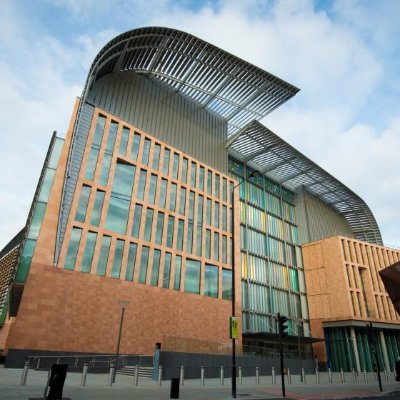
The Boulton Lab
@BoultonLab
Followers
2K
Following
63
Media
59
Statuses
123
Our diverse lab at @TheCrick studies mechanisms of DNA repair at breaks/forks/telomeres in health & disease | Now on 🦋 https://t.co/FmdsgaKaUd
London, UK
Joined November 2020
Similar results are obtained by independent labs @makotothayashi2 in Kyoto University/IFOM and @ZierLab at ICR.
0
1
7
Cells retained the ability to activate cGAS-STING in response to dsDNA or modified vaccinia virus infection. We provide evidence that micronuclei formed by genotoxic insults contain histone-bound self-DNA, which is inhibitory to cGAS activation. Link below
cell.com
Takaki et al. report that cGAS is recruited to micronuclei induced by genotoxic insults but fails to activate innate immune signaling. Failure to activate cGAS reflects the presence of inhibitory...
2
1
6
We observed cGAS localized to ruptured micronuclei via binding to self-DNA, yet we failed to observe cGAS activation across normal endothelialcells (HUVEC), keratinocytes (HaCaT) and fibroblasts (WI-38) as well as in cancer cell lines (HeLa, T24, SiHa).
1
1
7
Our latest is out! 🥳We found cGAS engaged w/ ruptured micronuclei can't activate downstream signalling. Our observation challenges current dogma that cGAS binds to self-DNA in micronuclei and triggers innate immune signalling. Spearheaded by Tohru @Wgctt1 with @Rhona_mill.
1
34
152
Long story short… 🧬 Amazing science in Rome, making ends meet, forza telomeres! @TeloEMBO2024
0
2
39
We have great news - our postdocs @MartinaPeritore and @RRJLow have been awarded #MSCA postdoctoral fellowships!! Congratulations 🥳🙌🏾👩🏾🔬👨🏾🔬 Looking forward to the exciting science to come!
1
2
36
@BoultonLab closes day 3 with a fabulous two part Plenary talk on ALT and the EXO1 story!! We hope to announce an exciting collaboration with Simon very soon… watch this space 🧬 #DRRSC24
0
1
10
In summary, we observed human BRCA2 is capable of nucleating RAD51 either directly onto ssDNA or ds-ssDNA junction; or via diffusion-assisted delivery aided by sliding along dsDNA. This work was a great collaborative effort between @BoultonLab, @SCWestLab and others. (10/10)
1
4
30
BRCA2 is mutated in breast and ovarian cancer. W/ help from Lucas Kuhlen (Xiaodong Zhang lab @ICStructBio) & @roopesh_anand we observed that BRCA2 truncations were impaired for RAD51 nucleation or sliding. C-terminus loss made BRCA2-DNA interaction particularly labile! (9/10)
1
0
2
Nucleosomes are very frequent physiological sliding barriers. With help from @GruszkaLab & @YardimciLab, we were able to capture sparsely chromatinized DNA between the two traps! Consistent with the sliding hypothesis, BRCA2 was unable to “jump” over nucleosomes either! (8/10)
1
0
2
Do address if BRCA2 slides or hops along DNA, we calculated diffusion coefficient (D) of BRCA2 while increasing the salt. D didn’t increase when DNA charge was shielded by NaCl indicating BRCA2 slides along DNA. BRCA2 molecules were also unable to “jump” over each other. (7/10)
1
0
1
Besides BRCA2 directly binding to RPA-ssDNA, we also observed BRCA2 molecules moving along the dsDNA arms! Some of them were even able to reach the gap edge and nucleate RAD51. We calculated BRCA2 diffusion rates using MSD analysis w/ help from @arthur_pol in @RuedaLab. (6/10)
1
3
15
When ssDNA is bound by RPA, human BRCA2 tends to nucleate RAD51 on the edges of the ssDNA gap, where the ds-ssDNA junctions are. We observed better preference for 5’ ds-ssDNA junction, consistent with early work using U. maydis BRCA2 homolog, Brh2. (5/10)
1
0
0
@BelanOndrej then used optical tweezers + fluorescence microscopy (C-trap by @LUMICS_nl) to observe BRCA2-mediated nucleation of labelled RAD51 on lambda DNA containing ~5.4 knt ssDNA gap bound by RPA. BRCA2 nucleated RAD51 on ssDNA and stabilized resulting RAD51 clusters. (4/10)
2
0
3
To address this, @LukeGreenhough in @SCWestLab optimized full-length human BRCA2 production to yield ~10000-fold more protein than reported before (Thorslund et al, 2010). BRCA2 fused to eGFP bound ssDNA with nanomolar affinity and loaded RAD51 onto ssDNA in bulk. (3/10)
1
0
2
BRCA2 is an important tumour suppressor, which nucleates RAD51 on RPA-coated ssDNA during DNA double-strand break repair by homologous recombination. However, detailed studies of this process were limited by BRCA2’s large size and its heterogenous/disordered nature. (2/10)
1
0
3
Our latest📰! Out today in @MolecularCell We used single-molecule imaging to directly observe human BRCA2 tumour suppressor in action! Spearheaded by @BelanOndrej & @LukeGreenhough. A thread. (1/10) https://t.co/hfn2uWSoOw
5
62
269
Yesterday we had a wonderful time at @TheCrick and heard about the cool work in @BoultonLab and @RuedaLab labs. An impressive building and a fantastic dinner! Looking forward to the next one. 🧬
1
5
27
We have open postdoctoral positions at Columbia University funded by our NIH T32 grant! If you are interested in studying genome or epigenome integrity, come and join us!
Interested in studying genome or epigenome integrity? We have NIH-funded T32 postdoctoral fellowships at Columbia University! @basulabcolumbia @EunheeChoi12 @DNAcurtain @LandweberLab @LuLaboratory @ShawnLiu_Lab @alisontaylorlab @zha_lab @CicciaAlberto
1
41
57
Congratulations to Prof Sir Steve Jackson on receiving a knighthood in the King's #BirthdayHonoursList for @SPJacksonGroup's pioneering research on the DNA damage response and its translation into the clinic. Well deserved, Steve! 👨🔬🧪🧬🎉🥳
Hearty congratulations to Prof Sir Steve Jackson, Senior Group Leader @CRUK_CI, who has received a knighthood in the King's first #BirthdayHonours List for his services to innovation and research 🎉 Read more about his remarkable achievement here⬇️ https://t.co/bUtHs3vPkb
0
0
17





